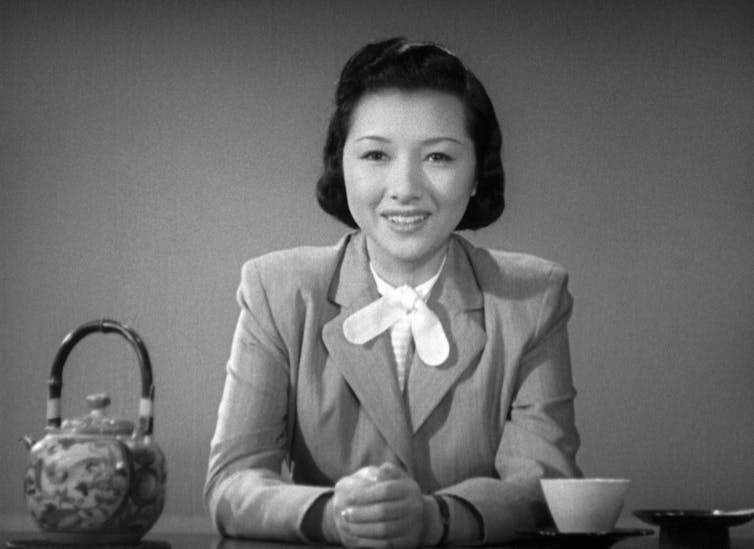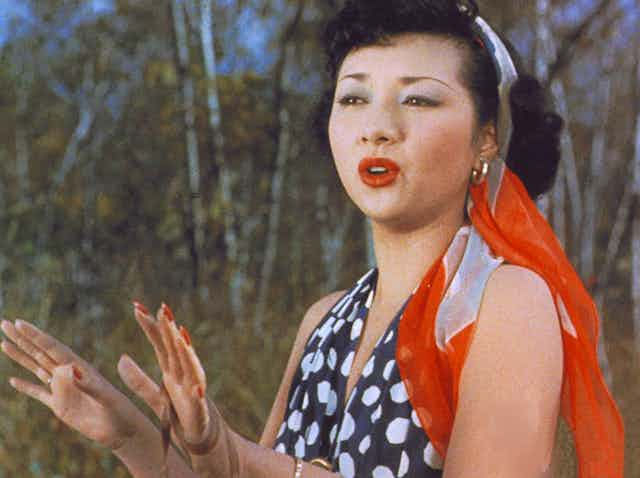In March 2024, Japanese film fans celebrated what would have been the 100th birthday of one of Japan’s most popular female film stars, Hideko Takamine (1924-2010).
Many of Takamine’s roles captured the essence of 20th-century Japanese society in flux, challenging and redefining what it means to be a woman through the decades.
Her performances are like time capsules, offering insights into the changing roles and expectations of women in a rapidly evolving Japan. They are compelling portraits by an artist whose work was closely linked to the upheavals of the 20th century.
These six films – some well-known, some more obscure – highlight the richness of her career, which spanned 50 years and more than 180 films.
1. Ginza Kankan Musume (1949)
In a fascinating blend of grit and optimism, this film showcases the complications of life in Tokyo just after the end of the second world war. As a tomboyish aspiring artist in dungarees, Takamine represents a new idea of Japanese women exploring creative freedom after the war.

Through her decision to abandon her beloved canvas and paints, joining a musical troupe that toured the cafés and night clubs of Tokyo’s Ginza district, the film symbolises Takamine’s own journey. In this reborn Japan, her bold act of taking agency carved out her place as an artist.
As an early post-war example of media-mix marketing, a record of Takamine singing the catchy title song was released at the same time. The film marks a significant milestone in Takamine finding her voice in postwar Japan.
2. Carmen Comes Home (1951)
Takamine takes the starring role in Japan’s first colour film. With vibrant dance scenes, Takamine questions traditional gender norms in her role as a striptease dancer.
Navigating the contradictory expectations and ideas of womanhood, her performance masterfully encapsulates the cultural and moral dilemmas faced by Japanese women during the postwar era.
Striptease in Japan was widely tolerated and even supported by the American occupation forces and is sometimes discussed as a marker of female freedom. But when Takamine’s character returns to her rural home, the film comically depicts the utter confusion of the people in her village. Is she a representative of the new age or just a glamorised sex worker?
3. Twenty-Four Eyes (1954)
This poignant antiwar film cast Takamine in perhaps her most famous role – as a primary school teacher witnessing the devastating impact of militarism and war on her students in rural Japan.
Takamine’s heartrending portrayal, grappling with the moral quandaries of wartime, deeply moved its audience. While its exclusive focus on Japanese victimhood has been highlighted by film critics including Sato Tadao, a pioneer in the research of Asian films, the open depiction of Japanese suffering was novel after years of American postwar censorship.

This novelty, along with the film’s use of nostalgic music, goes a long way to explaining the film’s impact. Takamine’s transformation from youthful educator, shocking the rural people riding a bicycle to work (how unladylike…), to a broken woman in mourning is unforgettable.
4. When a Woman Ascends the Stairs (1960)
Takamine delivers a powerful performance as Keiko, a widowed bar proprietor navigating the complexities of running a hostess bar on her own.
Keiko struggles financially, but what are her options? Giving in to her male customers, waving their wallets around while they vie for her affection and her body? Should she start a new business altogether? Or get remarried, possibly to one of the more decent looking regulars?
Takamine’s own persona as a film star, finding her own way as an independent woman without relying on a man’s money, is intertwined with Keiko’s story. This is what gives the film its authentic power. It’s one of Takamine’s most haunting performances – and a strong warning to her fans never to rely on a man.
5. The Happiness of Us Alone (1961)
Takamine was married to screenwriter Matsuyama Zenzō in 1955. The marriage fitted her developing persona and was celebrated as a partnership between equals. The groom was far from being a good catch financially for the film star.
The Happiness of Us Alone was Matsuyama’s debut as a director, and this collaboration was a manifestation of their artistic partnership, with the film celebrating marital love.
Portraying a deaf couple’s struggle against postwar societal challenges, the film delves into disability and social inclusion. Takamine’s commitment to authenticity, demonstrated by her learning sign language for the role, adds a layer of depth and empathy to this powerful story.
6. The Wife of Seishu Hanaoka (1967)
By 1967, Takamine was a seasoned veteran in front of the camera. And in The Wife of Seishu Hanaoka, she skilfully deploys her talents to show the darker side of the human soul – and the sacrifices some women are ready to make for men’s affections.
Takamine plays the jealous mother of a historical Edo period surgeon, embroiled in rivalry with her daughter-in-law for his affection. They go so far as to offer themselves as human guinea pigs for his often-terrifying experiments with anaesthesia and appear willing to sacrifice their health and even their lives for his success.
Takamine’s chilling depiction of determination and contempt for her daughter-in-law remains unsettling to this day. Men in Japan often remain the sole breadwinners for their families, making their success critical for the family and relegating the women to a background role.

These six films represent just a small fraction of Hideko Takamine’s wide-ranging oeuvre, but together provide a fascinating insight into her acting prowess and the themes running through her work. Takamine was an iconic artist whose work reflected and shaped womanhood in 20th century Japan.
In the year of her 100th birthday, these powerful and authentic performances are ripe for rediscovery and deserve to be more widely seen outside Japan.

Looking for something good? Cut through the noise with a carefully curated selection of the latest releases, live events and exhibitions, straight to your inbox every fortnight, on Fridays. Sign up here.

